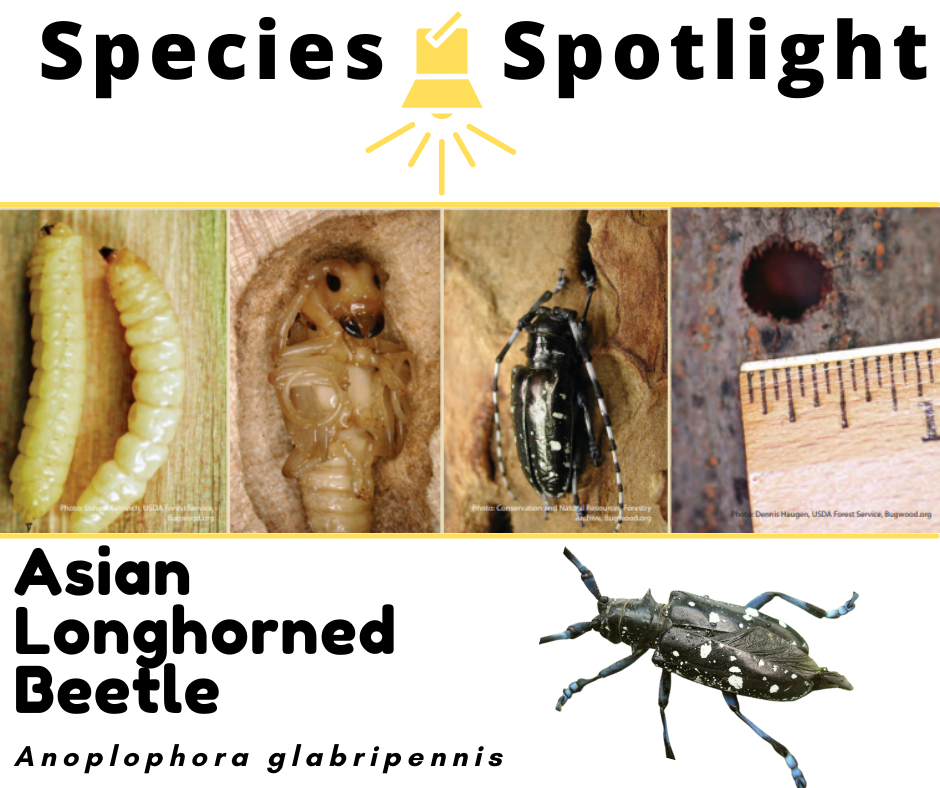Description
The long-horned beetle, ALB (Anoplophora glabripennis), is a wood-boring invasive insect native to China and Korea.
It was first seen in the US in the mid-1990s, possibly introduced on shipping crates or in wooden packing materials. It has spread to new areas since its initial detection. To date, it has not been found in the St. Lawrence Eastern Lake Ontario (SLELO) region.
Impacts
ALB larvae bore through the woody tissue of many species of hardwood. This disrupts the flow of nutrients and water through the tree. Eventually, the tree weakens and dies from the infestation.
Because the ALB targets several species of hardwood, the impacts of its infestation could be severe (ALB host trees).
Hardwood trees are used for lumber, furniture, and building homes. Maple syrup production could also be impacted. Most of our local, state, and federal parks contain many of these species. Backyards, gardens, and nursery stock will also be affected.
Signs of Infestation
- Chewed round depressions in the bark of a tree
- Pencil-sized, perfectly round tree exit holes
- Excessive sawdust (frass) buildup near tree bases
- Unseasonable yellowed or drooping leaves

Identification
Adult ALBs are 1 to 1/2 inches long. They are black with white spots and very long antennae. Their feet are bluish. Adults can be seen from June through October. They spend this time finding mates and laying eggs.
ALB is often confused with the native white-spotted sayer. You can distinguish this native beetle from the invasive ALB by looking for the presence of a white spot (scutellum) on the torso.
Life Cycle
Asian long-horned beetles have four life stages. Adult females chew depressions into the bark and lay eggs into these depressions. When the eggs hatch, the larvae eat into the tree, boring a tunnel as they feed on the wood. These tunnels, also called galleries, create gaps in the wood, making it hard for nutrients and water to flow from the roots to the crown. This causes the tree to weaken over time and, eventually, die.
The larvae pupate under the bark layer and emerge as adult beetles. The adults chew through the bark to get out of the tree, creating 3/8 inch, round holes that may ooze sap or sawdust, called frass. (The holes can look similar to holes made by maple syrup spiles, which are usually located at breast height around a tree.)
Management
Note: Successful management strategies may require a multi-year effort. Always follow chemical label instructions.
Manual/Mechanical: Remove and chip or burn infected trees. Tree must be chipped no larger than 1 inch in two dimensions. Roots of host trees should be removed to a minimum of 9 inches below the ground. Trees may be moved to an approved burning site via tarped or covered vehicle and held no longer than 24 hours prior to burning at site.
Chemical: Soil or trunk injection of systemic insecticide Imidacloprid can be applied by a licensed applicator. This method has been
successful on adults, egg laying females and young larvae.
Restoration
To aid recovery of an invasive forest pest invasion it is important to develop a plan to replace trees that may have been taken out, or killed off.
SLELO PRISM has developed an Urban Forest Sustainability Guide that outlines this proecess and provides an overveiw of host tree species of various invasive pests and reccommended alternate tree species in which you could consider planting.
Key Concepts:
- Plant wisely. Avoid planting trees that are known host species to invasive pests.
- Plant the right tree in the right place. Considering environmental suitatility for your desired tree species is vital for tree health.
- Diversity what you plant. Planting a variety of tree species enhances resiliency against forest pests.
Resources
Learn how to identify the invasive Asian Longhorned Beetle in this fast paced video field guide.
- Inspect your pool filter and water for Asian longhorned beetle (ALB). From late July until you close your pool.
- If you find an insect you suspect is ALB be sure to freeze the insect in a plastic bag and keep it until you receive confirmation.
- Take a photo. Photograph any insect you think might be ALB. Be sure to get a close-up of the insect’s back torso.
- Send the photo to the NYS Department of Environmental Conservation. Please include your name and address. Choose one of the three ways below to send your photo.
- Email. Send an email to foresthealth@dec.ny.gov with the subject heading “ALB Pool Survey”.
- Text. Text an image to (518) 810-1609, and type “ALB Pool Survey” in the body of the text.
- Mail. Send a printed image to the Forest Health Diagnostic Lab at 108 Game Farm Rd., Delmar, NY 12054.







